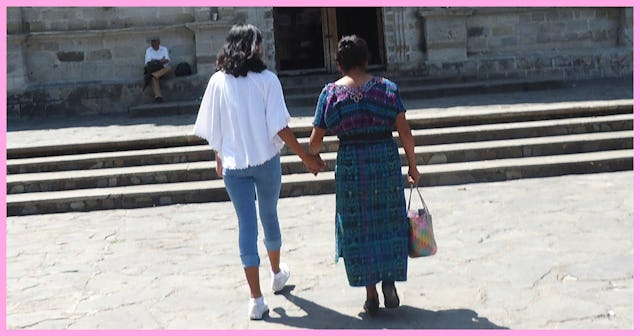My Daughter's Yearly Visits With Her Birth Family Make Her Feel Whole

The Guatemalan searcher I hired to find my daughter’s birth mother, Ana, told us to meet in Panajachel, which the town guide books refer to as Gringotenango. “In San Luis where Ana lives, they don’t see a lot of white people,” the searcher explained, referring to me, the white adoptive mother. “Better to meet someplace else.”
That first meeting happened when Olivia was seven. Most of the photos I took from the reunion are blurry, because I was crying too hard to keep my camera steady. To see Olivia and Ana fall into each other’s arms, and hold on as if afraid to let go, left me shaking.
Their black hair and brown skin, their slim bodies and elegant fingers, their quietness and ability to be still in a way I’ve never witnessed in anyone else: If I ever doubted the invisible bond of blood, meeting Ana convinced me of its presence. My daughter seemed to feel the same. She stared into Ana’s face as if amazed. Here, finally, she saw herself reflected.
Since then, Olivia and I have visited Ana every summer, spending time in Panajachel with her and Olivia’s older half-siblings, Dulce and Santiago, and Olivia’s grandmother, Abuela. Like many adoptive parents, I believe reunion helps a child feel whole, filling in the blanks of “Who am I? Where did I come from? Does anyone look like me?”
Courtesy of Jessica O’Dwyer
Our routine is always the same. We wait at Panajachel’s one gas station for the chicken bus from the mountains to arrive. Ana clambers down the steps of the bus in her woven skirt and embroidered blouse, and straight into Olivia’s embrace. Dulce and Santiago climb down next, with another round of hugging. Finally, Abuela appears, and the group opens to include her.
Later, we share a meal at a restaurant. Olivia and her siblings play cards and draw pictures while Ana and I pore over the latest photo album. The family speaks K’iché as well as Spanish and Olivia’s and my Spanish skills are developing. Yet somehow everyone communicates.
Ana told no one about her pregnancy. She was in her mid-thirties, a widow, and Catholic, when Olivia was born, in a clinic ten hours away in the town where Ana worked. In villages like San Luis, women who give up children for adoption are scorned and reviled. Sometimes they are forced to kneel on broken glass. Sometimes they are covered in tar. The day the searcher knocked on Ana’s door with a letter from me was the day Ana’s other children learned of Olivia’s existence. To keep the family protected, Ana made them promise not to share the news. Since our first meeting, they’ve treated Olivia as one of their own, accepting her as their full sister.
On a Tuesday in July when Olivia was thirteen, Ana arrived in Panajachel by chicken bus at the appointed spot at the appointed time. But instead of clambering down the steps with Dulce and Abuela, she climbed out the bus’s back door alone. “Today we will meet at my house in San Luis. Dulce’s baby is too young to travel. And Abuela is too old.”
Courtesy of Jessica O’Dwyer
Knowing Ana had kept her pregnancy a secret, I was surprised. Nervous, too. In our trips to Guatemala, we hadn’t veered far from the tourist trail, and San Luis was too small to appear on a map. At the same time, I felt deeply honored by the invitation. “What do you think?” I asked Olivia. Half an hour later we hopped on the next bus for the return journey.
One chicken bus, one micro-van, and one uphill hike later, we stood in the lane at the gate in front of Ana’s adobe house. The roof was made of corrugated tin, and wood smoke curled from the chimney. Clothes flapped in the wind on the long clothesline, and beyond that, rows of corn grew tall and dense and green. Chickens clucked and skittered and pecked in the dirt. A single spigot supplied the family’s only running water. We walked through the yard and a yapping dog ran in circles to greet us. “What’s your dog’s name?” Olivia asked, and she laughed when Ana answered “Bob.”
The house had a door but no windows and smelled of wood smoke and corn. Two pictures hung on the wall in the kitchen: One of Pope John Paul II, fingers raised in a blessing. The other of Olivia, Ana, and Abuela, walking hand in hand.
Olivia and I sat on plastic stools at a small wooden table while Ana served a lunch of fried chicken and squash. The corn tortillas were handmade that morning from Ana’s crop; the Coca-Cola bought special for the occasion. Abuela gave Olivia a necklace fashioned from Rosary beads and Dulce let Olivia hold her new baby. Tears sprang to my eyes as I watched four generations of Olivia’s family interact. We’ve closed a circle and expanded it.
After we finished lunch, Ana jumped up and dashed outside. A minute later, a hundred firecrackers ignited, loud enough for every person in San Luis to hear. Ana’s daughter Olivia had come home.